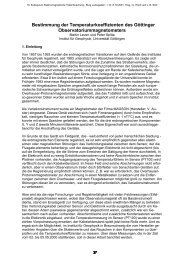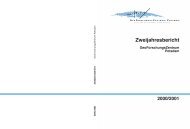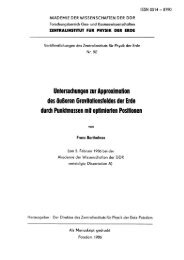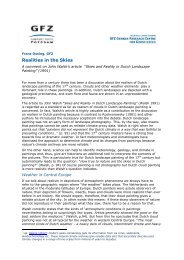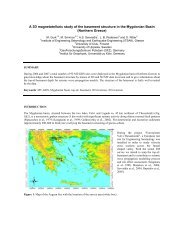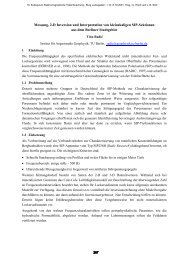Merkblatt Tsunami - GFZ
Merkblatt Tsunami - GFZ
Merkblatt Tsunami - GFZ
You also want an ePaper? Increase the reach of your titles
YUMPU automatically turns print PDFs into web optimized ePapers that Google loves.
1<br />
<strong>Tsunami</strong> Leaflet<br />
Causes and typical phenomena of <strong>Tsunami</strong>s<br />
and what to do in the event of an acute <strong>Tsunami</strong> risk or warning<br />
Prepared by Prof. Peter Bormann<br />
This leaflet is intended to inform those staying temporarily or for longer periods in coastal<br />
regions at risk of tsunamis<br />
1. about the causes and characteristics of tsunamis,<br />
2. where tsunamis can occur,<br />
3. how frequently tsunamis occur, with and without damage,<br />
4. what effects large tsunamis have,<br />
5. about tsunami early detection and warning,<br />
6. about questions one should be asked in regions at risk of tsunamis, and<br />
7. about preventive action and what to do in acute situations.<br />
Please note: The following information and recommendations have been prepared to the best of our<br />
knowledge. Nevertheless, the GeoForschungsZentrum Potsdam cannot be made responsible or accept any<br />
liability whatsoever for losses incurred as a result of following the advice given below.<br />
Summary<br />
• <strong>Tsunami</strong>s consist of a series of consecutive, very long period sea waves. These are mostly caused<br />
by strong submarine earthquakes, but also by volcanic eruptions or landslides.<br />
• <strong>Tsunami</strong>s can cause enormous damage to coastal areas near to their origin and cost many lives<br />
within a few minutes. But the effects of large tsunamis can also unfold on far distant coasts, as<br />
they can propagate across whole ocean basins within hours.<br />
• The speed with which tsunamis spread depends on the water depth. In shallow water they reach<br />
speeds of around 30 to 50 km/h and in deep oceans over 800 km/h.<br />
• The distances between the wave crests in deep, open sea is several hundred km and reduce in<br />
shallow water areas to around 10 km. The wave crests occur at intervals of around 10 minutes up<br />
to an hour.<br />
• The wave crests are low in deep, open sea, mostly between 30 and 80 cm and are harmless. As<br />
they approach the coast, especially in shallow bays, they can reach heights of over 10 m, and in<br />
extreme cases they can be more than 30 to 50 m high, flooding flat land behind the coast up to<br />
several kilometres inland and can cause horrific devastation.<br />
• Most tsunamis occur in the Pacific Ocean, although they also arise in all other oceans and sea<br />
areas. Although tsunamis rarely occur, they pose a great threat, as the disaster of 26. 12.2004 in<br />
the Indian Ocean shows.<br />
• The risks triggered by tsunamis can only be countered with prevention and early warning<br />
programmes and broad public information.<br />
• To date, an operative international tsunami warning system and several national systems have<br />
only existed in the Pacific. They are currently being developed or planned for other oceans and<br />
seas.<br />
• The existing tsunami warning systems have to date only been effective in alarming coasts that are<br />
several hundred or thousands of kilometres away from the area of origin. This enables early<br />
warning times of tens of minutes up to several hours. Warnings can then be given through various<br />
media and, in the best case, orderly evacuation of the coastal regions directly at risk can also be<br />
realised. In such cases, the disaster and civil defence organisations’ instruction must always be<br />
followed.<br />
• In the case of local, which reach nearby coastal zones within a few minutes, at best warning<br />
signals and brief instructions can be broadcast, calling upon the population to immediately<br />
evacuate the areas at risk of potential flooding. The people must then move, as soon as possible, to<br />
Version 08/07<br />
© GeoForschungsZentrum Potsdam is a Helmholtz-Centre
2<br />
higher ground, locations further away from the coast or designated emergency accommodation,<br />
possibly in the upper storeys of stable reinforced concrete high-rise buildings or hotels.<br />
• If ships or boats on the open sea receive tsunami early warnings, they should definitely not put<br />
into harbours or bays but should move as far away as possible from the coast until the all clear is<br />
given or after contacting harbour authorities who explicitly release calling at and anchoring in<br />
harbours again.<br />
• If ships and boats in harbours or bays receive tsunami early warnings, and if the early warning<br />
time is sufficient to reach deeper open sea, they should immediately set sail. However, this can be<br />
risky for smaller and slower boats, especially in storms on high seas. The crew should then<br />
immediately go ashore and look for higher places of refuge as quickly as possible.<br />
• A tsunami consists of several wave crests, which follow each other at intervals of tens of minutes<br />
up to more than one hour and frequently rise and accumulate in subsequent wave crest, reaching<br />
maximum heights at the coast. Therefore, people should never leave their refuges after the first<br />
wave(s) have receded. They may have to stay in the higher places of refuge for more than 5 hours<br />
and should not return to the lower-lying coastal areas until receiving an official all clear.<br />
• Many countries at risk of tsunamis currently have neither technical-administrative early warning<br />
systems nor official plans for evacuation routes and refuges in the event of a disaster.<br />
Nevertheless, many lives can be saved by registering the following phenomena and acting as<br />
described above:<br />
• If you are near the coast and feel a strong earthquake, you should immediately hasten to a higher<br />
refuge or a place far from the coast, as earthquakes near the coast can trigger tsunamis. However,<br />
only around 10 to 20% of all such quakes are followed by a dangerous tsunami. Nevertheless, you<br />
should not rashly return to lower areas close to the coast, but if possible should wait for an official<br />
all clear, unless you can safely assess from your position that a tsunami has not followed the initial<br />
tremors within an hour.<br />
• If you feel strong earthquake tremors while in a building, follow the instructions in the<br />
Earthquakes leaflet. If the building is located in the potential tsunami flood zone, leave the<br />
building immediately after the tremors recede and hurry to a higher location or a place further<br />
from the coast (exception: well-built reinforced concrete high-rise buildings not damaged by the<br />
earthquake).<br />
• If you are on the coast and notice an unexpectedly fast rise or fall in the water level within<br />
minutes, you should also hurry to a higher location or a refuge further away from the coast. You<br />
should never run into bays that suddenly become dry. The first high tsunami wave will definitely<br />
follow within a few minutes.<br />
• Inform the people near you of the phenomena you have registered and warn them accordingly.<br />
For more details on the causes, characteristics, areas of origin and impact, frequency and effects of<br />
tsunamis and questions you should ask the authorities in regions at risk of tsunamis and what to do,<br />
please refer to the in-depth “<strong>Tsunami</strong> information sheet”<br />
Version 08/07<br />
© GeoForschungsZentrum Potsdam is a Helmholtz-Centre
3<br />
<strong>Tsunami</strong> Information Sheet<br />
Prof. Peter Bormann<br />
Please note: The following information and recommendations have been prepared to the best of our<br />
knowledge. Nevertheless, the GeoForschungsZentrum Potsdam cannot be made responsible or accept any<br />
liability whatsoever for losses incurred as a result of following the advice given below.<br />
1. Causes and characteristics of tsunamis<br />
<strong>Tsunami</strong> is a Japanese word. “tsu” means harbour and “nami” means wave – i.e. “harbour wave”. A<br />
tsunami is therefore a wave, which has particularly marked characteristics in harbours and bays where<br />
it often causes extensive devastation. Such a wave is caused by sudden rising or lowering of the ocean<br />
floor or by large masses of earth falling or sliding into the water and propagates as consecutive, very<br />
long period ocean waves over long distances.<br />
<strong>Tsunami</strong>s are mostly (around 90%) triggered by strong earthquakes below the ocean floor. One of<br />
the largest tsunamis in the 20 th century, with a water front of up to 70 m arose during the Alaska<br />
earthquake of 28 March 1964. During this quake the earth’s surface shifted within an area of around<br />
500,000 km², i.e. an area larger than Germany; rising by up to 12 m at the coast and lowering by up to<br />
2.3 m inland.<br />
<strong>Tsunami</strong>s resulting from volcano eruptions and due to submarine landslides are rarer, but are often<br />
no less vast. For example, around 8000 years ago a flood wave up to 30 m high flooded parts of Great<br />
Britain, Norway and Iceland. This tsunami was probably triggered by a large slip off the coast of<br />
Norway, in which rocky masses from the surface of Iceland fell 2000 m deep into the North Atlantic.<br />
During the explosion of the Krakatoa volcano in 1883, around 18 km³ of ash and slag were ejected<br />
into the Sunda Strait between Java and Sumatra. After the eruption, the previously 900 m high<br />
volcanic island collapsed and formed an over 200 m deep crater (caldera) in the sea. At the same time,<br />
a tsunami resulted, reaching heights of up to 35 m in several coastal bays, flooding flat coastal areas 2<br />
to 10 km inland and claimed 36,000 lives.<br />
Large cosmic projectiles impacting the sea can also cause enormous tsunamis; however, these events<br />
are extremely rare. The extinction of many dinosaur species around 65 million years ago is attributed<br />
to a meteorite impacting the area of the present day Gulf of Mexico.<br />
Fig. 1 shows a schematic of how the devastating tsunami formed in the Indian Ocean as a result of the<br />
strong Sumatra earthquake on 26.12.2004. In this area, the oceanic crust moves from the west (left) to<br />
the east, collides with the Sumatra crustal plate and dives under it. This is called subduction. But it<br />
does not occur uniformly. In the area of contact, the two rock places collide and get hooked on each<br />
other. This caused the crustal plate of Sumatra to be flexed downwards and to the east (right) and a<br />
deep-sea trench was formed off the coast of Sumatra. On 26.12.2004, the enormous stresses<br />
accumulated over decades suddenly caused the plate contact to rupture over an area of more than<br />
100,000 km 2 . The Sumatra plate sprung back to the left (west) and upwards by around 13 m. The<br />
resulting earthquake with a strength of Mw = 9.3 on the Richter scale was the second strongest to occur<br />
in the past one hundred years. The ocean floor in the area of the Sumatra plate was raised by 2 to 3 m<br />
and caused asymmetrical upheaval and sinking of the water column above it (Fig. 1, centre). This<br />
began to vibrate and to propagate in all directions with several wave crests and troughs (Fig. 1,<br />
bottom). In total, this tsunami claimed around 300,000 lives, destroyed several hundred thousand<br />
homes and left behind around 3 million homeless.<br />
Version 08/07<br />
© GeoForschungsZentrum Potsdam is a Helmholtz-Centre
4<br />
Fig. 1: Schematic diagram of the development of the tsunamis on 26.12.2004.<br />
<strong>Tsunami</strong> waves oscillate very slowly. Their period, i.e. the time interval between consecutive crests,<br />
varies between several minutes up to around two hours, depending on the water depth and the type,<br />
size and spatial orientation of the initiation process in the area of origin. The tsunami’s propagation<br />
velocity depends on the water depth. In the deep sea it equals that of a jet liner, and in shallow water it<br />
is roughly the speed of a fast cyclist or sprinter. The wavelength, i.e. the spatial distance between<br />
consecutive wave crests and the wave height (amplitude) therefore also vary with the water depth<br />
(sketch and table in Fig. 2). The shallower the water, the shorter the distances between the waves and<br />
the greater their amplitudes, as the water masses are concentrated in an increasingly smaller space. The<br />
literature references therefore speak of so-called run-up heights at the coast. The tsunami wavelengths<br />
therefore vary within a wide range of between around 10 km and 700 km.<br />
Version 08/07<br />
© GeoForschungsZentrum Potsdam is a Helmholtz-Centre
5<br />
Fig. 2: Schematic diagram of the relationship between the wavelengths and amplitudes of a tsunami<br />
and water depth. (Taken from [1]).<br />
One consequence of this tsunami characteristic is that on high seas, even large tsunamis with<br />
amplitudes of mostly only a few decimetres cm are not registered due to the enormous wavelengths of<br />
several 100 km. They therefore cause no risk to ships on high seas. It is only in the shallow waters of<br />
the coastal areas that the dangerous water fronts build up to several 10 m.<br />
The wave periods, lengths and run-up heights of tsunamis are also influenced by the horizontal coastal<br />
outline, the vertical profile in shallow waters and by the water’s natural oscillation in the shallow<br />
continental shelf and in bays into which the tsunami runs. Ebb and flow conditions at the time the<br />
tsunami reaches the coast also play a role. The dominating influence of coastal shape and shallow<br />
water profile on the observed run-up heights are also made clear by detailed observations of the<br />
tsunami of 12 July 1993 in the Sea of Japan following an earthquake near the coast with a magnitude<br />
of M=7.8. On the coast of Hokkaido and the island of Okushiri just off the coast, around 50 to 200 km<br />
from the earthquake epicentre, different run-up heights of between 1 m and 32 m were measured!<br />
Severe devastation can also occur on (peninsular) island coasts on the side facing away from the<br />
tsunami, as a result of diffraction or refraction of the long period tsunami waves in the shallow water<br />
fringe (e.g. on the SW coast of Sri Lanka around Galle during the tsunami of 26.12.2004).<br />
These diverse influences make it very difficult to precisely predict the height and timing of tsunami<br />
waves and the size of the flood areas on coasts at risk. Such scenarios can only be approximately<br />
calculated for specific and precisely known or assumed tsunami sources and coastal situations. The<br />
possible flood areas, according to which the evacuation zones and refuge areas are to be defined by<br />
disaster managers, should therefore not be assumed to be too small.<br />
Most tsunamis do not penetrate the flat coastal hinterland by more than several hundred metres;<br />
however, distances of several kilometres can be reached by the strongest. For example, 18 th , 19 th and<br />
20 th century tsunamis repeatedly caused flooding of 2 to 3 km of several coastal areas of Chile and in<br />
the Sumatra quake of 2004 caused flooding 2 to 7 km inland along the coast of Thailand, the Nikobar<br />
islands and North Sumatra. The tsunami caused by the Krakatoa eruption of 1883 penetrated the<br />
Pepper Bay of Java by up to 10 km inland. <strong>Tsunami</strong> effects were detected even further inland in the<br />
estuary of wide rivers, among other things due to backwater, e.g. up to 30 km along the Imperial River<br />
in Chile following the earthquake of 1960.<br />
On the other hand, the propagation time of tsunamis through areas of deep seas and oceans can be<br />
calculated very quickly and precisely, as soon as the origin (the epicentre) is known. Fig. 3 shows the<br />
result of such a calculation by the Pacific <strong>Tsunami</strong> Warning Center (PTWC) in Honolulu for a quake<br />
off the coast of North Chile. Fig. 4 shows an analogous illustration of <strong>GFZ</strong> Potsdam for the tsunami of<br />
26.12.2004 in the Indian Ocean. Both diagrams clearly show that there is adequate early warning time,<br />
Version 08/07<br />
© GeoForschungsZentrum Potsdam is a Helmholtz-Centre
6<br />
at least for distant coastal areas, if the causative seismic centre and resulting tsunami can be localised<br />
and more precisely described quickly enough (cf. also Section 6.).<br />
Detection characteristics of tsunamis<br />
Although destructive waves and extensive flooding of flat coastal areas are the main characteristic of<br />
large tsunamis, their arrival at the coast – compared to the sea tides – is often preceded by a very<br />
rapid rise or even fall in the water level within a few minutes. This is an important, mostly unknown<br />
or ignored, early warning sign. Whether the sea level rises or falls, depends on the type and spatial<br />
orientation of the triggering process, the propagation direction of the waves, the orientation of coastal<br />
bays, and other influences. For example, on 26.12.2004, the water level off the coast of Thailand fell<br />
by several metres before the arrival of the first tsunami wave. If this relationship had been commonly<br />
known, and had the people on the coast immediately fled to the higher areas of the hinterland, many<br />
thousands of lives would have been spared.<br />
Fig. 3: Calculated propagation time for the first wave of a tsunami, which was triggered by an<br />
earthquake off the coast of North Chile. The numbers on the isolines give the propagation time<br />
in hours. The dots mark the position of tidal stations in the Pacific, which record fluctuations<br />
in the sea surface levels and send them to PTWC by satellite (taken from [1]).<br />
Version 08/07<br />
© GeoForschungsZentrum Potsdam is a Helmholtz-Centre
7<br />
Fig. 4: Propagation times of the first wave front of the tsunami of 26.12.04 through the northeastern<br />
part of the Indian Ocean.<br />
Fig. 5 shows registrations of the seal level in Antofagasta (Chile) and Kaimaisi (Honshu, Japan)<br />
between 22 and 24 May 1960. The around 12-hour period of the sea tides (ebb and flood) can be<br />
clearly seen. It is superimposed by substantially faster fluctuations with periods between around 18<br />
and 55 minutes and at times much larger amplitudes. These are tsunami waves, which were triggered<br />
by the Chile earthquake of 22 May 1960, the strongest earthquake to date to be recorded by<br />
instruments (magnitude 9.5 on the Richter scale). The level gauge in Antofagasta was approximately<br />
1,800 km from the earthquake’s epicentre and the one in Kaimaisi was around 18,000 km away. Fig. 5<br />
shows further important tsunami characteristics:<br />
Version 08/07<br />
• The periods of a tsunami can vary considerably, not only in various directions and<br />
distances from the origin, but also for consecutive wave crests at the same location;<br />
• In most cases, the first tsunami wave is not the largest. Subsequent waves, sometimes the<br />
fifth or sixth, can be many times stronger. As these late waves often do not arrive until<br />
many hours after the first wave, refuges should never be left after the first wave(s)<br />
has/have receded! (see Section 7).<br />
• Even at very large distances from the area of origin, tsunamis can still be dangerous.<br />
During the Chile tsunami of 1960, more than 250 people were killed in Japan.<br />
© GeoForschungsZentrum Potsdam is a Helmholtz-Centre
8<br />
Fig. 5: Level gauge registrations of ebb and flood in Antofagasta, Chile (top) and Kamaishi, Japan<br />
(bottom), superimposed by the shorter periods of tsunami waves of the Chile earthquake, 1960.<br />
2. Where do tsunamis originate and where can they cause damage?<br />
Most strong earthquakes occur in so-called subduction zones (“forcing underneath” or “engulfing”<br />
zones). This is where the earth’s oceanic crust collides with a thicker continental crust or with another,<br />
younger oceanic crust plate, is pushed under it and sinks into the earth’s hot mantle. During this<br />
process, stresses permanently develop in the earth’s crust, which are released by – at times strong –<br />
earthquakes. Almost the whole Pacific edge, in which around 80% of the worldwide energy triggered<br />
by earthquakes is released, consists of subduction zones. This is why the most tsunamis occur there.<br />
Yet devastating tsunamis can also occur in other oceans and seas such as the Atlantic, the Indian<br />
Ocean and the Mediterranean. However, only around 10 to 20% of the strong earthquakes with Richter<br />
magnitudes of over 6.5 in the area of the seas and oceans trigger tsunamis, and at magnitudes M < 7.5<br />
these usually only have regional effects within a radius of a few 100 km from the causal epicentre.<br />
Fig. 6 shows the worldwide distribution of the most important earthquake, volcano and tsunami<br />
zones of the earth. Above all, these are the tectonically active edges of the large continental and<br />
oceanic earth’s crustal plates. These plates float on the viscous, hot molten magma of the upper mantle<br />
and slowly drift (a few cm per year). They slide past each other, shift on top of each other, get hitched<br />
onto each other and then tear apart again. Within the plate collision zones, new mountains pile up on<br />
the continents or island chains form off the continents, and submarine mountain ranges and volcanoes<br />
form along the major oceanic fault zones (so-called rift zones); identifiable by the beaded-like<br />
arrangement of earthquake epicentres in the oceans. These processes are called global pate tectonics.<br />
They have been occurring on the earth for more than 3.5 billion years and constantly change the face<br />
of our planet. They cannot be influenced by man and will continue to act for billions of years to come.<br />
The resulting risks for human society must be identified and counteracted through deliberate action.<br />
Version 08/07<br />
© GeoForschungsZentrum Potsdam is a Helmholtz-Centre
9<br />
Fig. 6: Worldwide distribution of the most important earthquake, volcano and tsunami zones,<br />
compiled by <strong>GFZ</strong> Potsdam (2000). However, isolated large tsunamis can also arise or have<br />
effects in other locations, like the Sumatra–tsunami of 26.12.04 on the coast of Somalia,<br />
Kenya and Tanzania.<br />
Of the very reliably recorded tsunamis that have occurred during the past 140 years, almost 25%<br />
occurred in Japan. The west coasts of South America, North and Central America, Indonesia, the<br />
Philippines and New Guinea and the Solomon Islands were each equally affected by around 10% of<br />
the events. They are followed by Kurile-Kamchatka, Alaska and New Zealand with around 6% of the<br />
events each. During this period, only around 2 to 3% of the recorded tsunamis occurred in the<br />
Mediterranean region, Hawaii and the coastal areas of the Atlantic and Indian Ocean.<br />
Fig. 7 shows all tsunamis documented in international tsunami databases since 2000 BC for the Pacific,<br />
the Indian Ocean (Indic) and the Atlantic (including its intracontinental seas). Of the events recorded<br />
with deaths, 79% are in the Pacific, 14% in the Atlantic and 7% in the den Indic. However, due to the<br />
different cultural development of the regions during the history of man, these frequencies are neither<br />
complete nor representative for the actual long-term frequency of the occurrence of large tsunamis.<br />
Around 70% of all those named occur during the past 200 years alone. They also say nothing about<br />
their potential dangerousness. This is proven by the earthquake of 26.12.04 when the tsunami claiming<br />
the most lives in history occurred in the Indic.<br />
Version 08/07<br />
© GeoForschungsZentrum Potsdam is a Helmholtz-Centre
10<br />
Fig. 7: All currently recorded tsunami events (partly uncertain) from a compilation of different<br />
international databases (according to [2]).<br />
3. Frequency of the occurrence of dangerous tsunamis<br />
Compared to earthquakes, volcanic eruptions and landslides/avalanches, tsunamis are rare events. A<br />
compilation of different databases gives almost 3000 entries worldwide for the period from 2000 BC<br />
until today, many with the comment “erroneous” or “questionable” to “very questionable” tsunamis.<br />
Over 2000 of these entries occurred during the past 200 years alone, not because the frequency of<br />
tsunamis has increased, but because of a rise in their recording and documentation. Less than half<br />
these events are listed as “definitive” or “probable” tsunamis. Of these, since 1562, around 100<br />
tsunamis have reached maximum run-up heights of 10 m and more and 26 tsunamis have reached<br />
heights of over 30 m (up to maximum 500 m during an enormous landfall in Lituya Bay, a fjord in<br />
Alaska). More complete frequency statistics since 1868 show that in the long-term average, over a<br />
period of 10 years dangerous maximum run-up heights of > 2 m were observed 23 times, >8 m eight<br />
times and >32 m only once ([2]).<br />
Version 08/07<br />
© GeoForschungsZentrum Potsdam is a Helmholtz-Centre
11<br />
Fig. 8: Number of von tsunamis with and without damage in the decades of the 20 th century<br />
(compiled according to information from the National Geophysical Data Center and the<br />
National Oceanic and Atmospheric Administration (NOAA) of the USA)<br />
Fig. 8 shows the frequency of tsunamis with and without damage in the decades of the 20 th century.<br />
Accordingly, during the past century, on average only around 10 tsunamis occurred per year, of which<br />
no more than 1 to 2, sometimes only one every 2 years, caused damage. Almost 90% of the tsunamis<br />
were triggered or initiated by earthquakes. The condition is that the earthquakes are sufficiently<br />
shallow and strong enough to fracture the earth’s crust up to the ocean floor. However, this is only the<br />
case for earthquakes with magnitudes M (strength on the Richter scale) higher than 6. In the long-term<br />
average, around 200 quakes of this strength occur on the earth each year. But only around 10 to 20%<br />
of these quakes also generate a sufficiently strong vertical movement of the ocean floor in order to<br />
trigger a tsunami. Only tsunamis with run-up heights of 2 m and more cause noteworthy damage.<br />
Apart from a few exceptions, these are usually generated by earthquakes with M>7. Of these, on<br />
average there are around 17 quakes per year worldwide (fluctuated in the 20 th century between around<br />
5 to 40 per year). Only around one in every tenth of them also generated a noteworthy tsunami.<br />
However, occasionally comparatively weak or very slowly occurring earthquakes, which are not<br />
perceived at nearby coasts or are registered as weak tremors only, can cause large submarine<br />
landslides or ocean floor displacements and thus result in tsunamis. This was, e.g. the case in the two<br />
tsunamis of 1992 in Nicaragua (run-up max. 9 m) and 1998 in Papua New Guinea (run-up max. 15 m)<br />
with severe damage and numerous deaths.<br />
4. <strong>Tsunami</strong> damage and risk<br />
Compared to direct damage resulting from earthquakes, volcanic eruptions or landslides/rock<br />
avalanches, most of which only occur locally or in spatially limited areas, tsunamis can cause<br />
devastation and claim lives on coasts thousands of kilometres away. The intention of this section is to<br />
highlight special features, which are important for decisions with respect to living, working and<br />
relaxation in areas at risk of tsunamis and what to do after such a disaster.<br />
Reefs and sandbanks/shallow water areas off a coast can reduce the destructive force of tsunami<br />
waves, and sometimes special wave-breaking structures, such as those built along several coastal<br />
sections of Japan at particular risk. Examples also exist where necessary culvert/throughway areas in<br />
such protective structures caused dangerous local increases in the flow velocity and wave height of the<br />
tsunami and therefore increase the damage in the area that should be protected.<br />
Version 08/07<br />
© GeoForschungsZentrum Potsdam is a Helmholtz-Centre
12<br />
Experience from Japan shows tsunami amplitudes below 1.5 m do not usually pose any risk to people<br />
and structures. However, there are cases, such as the night-time inrush of the tsunami of 1992 in<br />
Nicaragua where above all children, asleep on the floor in fishermen’s huts on the beach, were<br />
drowned in the water, rising in some places by only 1 to 1.5 m.<br />
If wave heights are over 2 m, most lightweight buildings made from wood, sheet metal, mud/clay, etc.<br />
are totally destroyed, if the waves are > 3 m high, concrete block buildings are also destroyed. If the<br />
wave heights exceed 4 m the number of deaths also rises drastically. Well-built reinforced concrete<br />
structures on the other hand can withstand tsunami waves at least 5 m high. Therefore, the upper<br />
storeys of reinforced concrete high-rise buildings/hotels can also be used as refuges in case of very<br />
short early warning times and small chances of escaping outdoors.<br />
<strong>Tsunami</strong>s often penetrate hundreds of metres into flat coastal regions, particularly high waves can<br />
even penetrate several kilometres, and not only destroy human settlements but also make agricultural<br />
land and wells unusable due to salination and sanding. As the water masses penetrate and flow back<br />
several times, the flood areas are covered with mud and sand, shattered objects and parts of buildings.<br />
Ships in harbours are thrown on land (Fig. 9), roads are blocked and railway tracks are washed away,<br />
and are therefore unusable. Low-lying harbour areas and fishermen settlements often stand under<br />
water for a long time and become uninhabitable (Fig. 10). In addition, there are risks caused by<br />
leaking barrels full of fuels and chemicals, flooding of wastewater treatment works or cesspits and<br />
often hundreds or even thousands of human and animal corpses. Especially in tropical regions, the<br />
acute risk of drinking water contaminations, the breakout of epidemics, etc. Direct tsunami damage is<br />
often intensified by the outbreak of fires resulting from broken gas pipes and electrical short circuits,<br />
often in conjunction with leaking fuel from stranded ships and vehicles or leaking tanks in harbours<br />
(Fig. 10).<br />
Fig. 9: Heaps of debris in Kodiak harbour, Alaska, after<br />
the tsunami on 27 March 1964 (Photo: R.<br />
Kachadorian, USCGS; taken from [3])<br />
Fig. 10: Devastation and fires in the harbour of Niigata on<br />
Honshu, Japan, after the tsunami and earthquake<br />
of 16 June 1964.<br />
Coastal biotopes (mangrove forests, coral reefs, etc.) can also be severely damaged and permanently<br />
destroyed by tsunamis.<br />
5. <strong>Tsunami</strong> early detection and warning<br />
The possibilities for early detection and warning grow with the distance of a coast at risk from the<br />
origin of the tsunami. If local monitoring networks exist in the area of origin (as is currently the case<br />
in Japan, Kamchatka and Alaska; such systems are currently being developed for several other areas),<br />
locating and estimating the strength and dangerousness of a tsunami and subsequent immediately<br />
initiated automatic warnings are possible within 5 to 10 min, depending on the development status of<br />
the technology used. For coastal sections further than 50 to 100 km (depending on the water depth and<br />
Version 08/07<br />
© GeoForschungsZentrum Potsdam is a Helmholtz-Centre
13<br />
therefore tsunami propagation time, see Fig. 2) from the epicentre, there is therefore a real opportunity<br />
for early warnings. Coastal inhabitants then have several minutes to reach a safe place.<br />
If regional tsunamis occur, e.g. in intracontinental and inland seas such as the Mediterranean, Black<br />
Sea, Sea of Japan, the Caribbean, the Gulf of Bengal, etc. warnings for more further away coasts at<br />
distances of several hundred up to 2000 km are possible in principle 1 to 3 hours before the tsunami<br />
reaches them (cf. Fig. 4). However, no technical early warning systems exist yet for the Atlantic and<br />
Indic and their intracontinental seas. Existing regional earthquake systems can be used for setting up<br />
such systems, specifically developed and supplemented with pressure sensors on the ocean floor and<br />
other oceanographic monitoring systems. Ocean sensors enable tsunami waves propagating from an<br />
excitation source to be recorded, their height determined and their propagation through the sea to be<br />
tracked.<br />
Apart from a large number of modern sensors for obtaining the necessary data, the prerequisites for a<br />
functioning early warning system are their immediate transfer (e.g. via satellites), processing virtually<br />
in real time and immediate infeed of the resulting findings into national and international, worldwide<br />
open information systems and forwarding to warning centres.<br />
The Pacific tsunami warning system for the Pacific Ocean has existed since 1965 and has an operative<br />
centre in Honolulu, Hawaii (PTWC – Pacific <strong>Tsunami</strong> Warning Center). It is supplemented by an<br />
international information centre (ITIC – International <strong>Tsunami</strong> Information Center). More detailed<br />
information is available from the ITIC’s web portal (http://www.prh.noaa.gov/itic/; with links to the<br />
Alaska <strong>Tsunami</strong> Warning Center and events in the Indic). If a tsunami risk exists for remote pacific<br />
coastal zones with adequate warning times, the PTWC issues a tsunami alarm level. If you receive<br />
such information through the media, strictly follow the official instructions.<br />
Organised responses and evacuations are no longer possible for local tsunamis, which occur directly<br />
off the coast and also not for the arrival of tsunamis originating from distant locations for which there<br />
are no official early warnings. Even then, you still have a good chance of saving your own life and<br />
those of others, if you attentively observe nature and know how to interpret unusual phenomena.<br />
How can you identify an imminent tsunami risk, which requires immediate response by each<br />
individual?<br />
• If official early warning systems exist, then a tsunami is signalled via agreed siren signals,<br />
messages via coastal radio or other media;<br />
• If you are in a coastal area and notice strong earth tremors, then this is an acute warnings that<br />
a tsunami is POSSIBLE and immediate action is appropriate (cf. Item 7even if only a few of<br />
the strong quakes actually trigger a dangerous tsunami;<br />
• It is important to know that earth tremors travel considerably faster than tsunami waves. This<br />
is why the earthquake of 26.12.2004 off Sumatra was felt in the province of Aceh 15 minutes<br />
before the tsunami wave arrived. This would have been sufficient time for correct tsunami<br />
response by the coastal inhabitants. In the event of tsunamis resulting from remote<br />
earthquakes or even (under certain circumstances even nearby) submarine earth slides and<br />
volcanic eruptions, however, in most cases there is no prior registration of tremors. In almost<br />
all tsunamis, however, the first large breaker wave is preceded by a relatively fast – compared<br />
to ebb and flood – RISE or FALL of the water level, often by several metres within 5 to 10<br />
minutes. Both are unmistakeable signs that the first large wave front will soon reach the coast<br />
(less than 30 minutes; depending on the period of the subsequent tsunami waves).<br />
Attentive observation of nature and immediate responsible response by each individual can therefore<br />
save lives. All people on the beach or the coast who either feel strong earth tremors or observe unusual<br />
behaviour of the sea level should bring this to the attention of all people around them and tell them to<br />
immediately leave the beach and all other flat coastal areas therefore at risk of flooding (cf. Section 7).<br />
Version 08/07<br />
© GeoForschungsZentrum Potsdam is a Helmholtz-Centre
6. Which questions should one ask in regions in which there is a tsunami risk?<br />
14<br />
People who temporarily stay or live in coastal areas of the regions of the earth most at risk from<br />
tsunamis (Fig. 5) should ask the following questions and obtain information from the hotel<br />
management, local authorities, the police, or disaster or civil defence organisations, etc:<br />
• Is the hotel/house/work building, etc. within a flood area within the event of a large tsunami?<br />
• If yes, in what building class respect to its height, stability and strength of the foundations, is<br />
the building in which you are to live or work classified?<br />
• Can the upper storeys of high (more than 3–storeyed) buildings with credible stability in an<br />
emergency be used as a refuge (cf. Section 4.)?<br />
• Does a plan of the areas at risk from tsunamis exist for the location/bay, etc. (designated<br />
maximum impact and flood zones) with recommended evacuation routes, collection points,<br />
emergency shelters?<br />
• How far away is the nearest high ground and other suitable refuges?<br />
• Does a functioning early warning system and tsunami management exist for the<br />
location/beach/coastal area and if yes, what alarm signals apply and what action should be<br />
taken? (If applicable, request leaflet)?<br />
• Is the hotel management/building management prepared to warn the residents at night in the<br />
event of an emergency and to give competent instructions on what to do? What type and<br />
through which media?<br />
You should be aware that to date it was not usual to ask such questions. You will therefore<br />
probably be met with a lack of understanding and often even displeasure, especially as in most<br />
countries all the aforementioned bodies cannot yet provide any useful information. Don’t let that<br />
put you off asking. Only questions repeatedly asked of these bodies by tourists, business people,<br />
politicians, etc. will produce the necessary moral, political and even economic pressure in order to<br />
make substantial disaster prevention and precaution progress within the next few years and<br />
decades. Several official bodies will even be grateful that they can refer to YOUR urgent<br />
questions, in their own efforts to obtain help, clarification and decisions from higher-ranking<br />
bodies.<br />
7. Preventive and pressing rules for action in tsunami areas<br />
• Knowledge is safety! Pass on your knowledge about tsunamis to others. This can help to<br />
save lives during future events.<br />
• Although tsunamis can be very dangerous and devastating, they nevertheless occur very<br />
rarely. You should therefore not spoil your pleasure in experiencing the sea and beaches<br />
even in countries at risk of tsunamis, but at the same time, you should be an attentive and<br />
knowledgeable observer of nature, even if nothing unusual happens for decades.<br />
7.1 What to do if you are outdoors<br />
• If you are in low-lying coastal areas or a river bank near the estuary and feel a severe<br />
earthquake, then warn the other people near you and hurry as quickly as possible to<br />
higher ground in the hinterland or on the coast.<br />
• Remember that tsunami waves can often reach heights of over 10 m at the coast, and in<br />
rare, extreme cases, more than 30 to 50 m. <strong>Tsunami</strong> waves dissipate quickly in the<br />
hinterland, but they can flood flat coastal areas several hundred metres up to several<br />
kilometres inland. Hills more than 10 m high at a distance of several hundred metres from<br />
the coast can provide a safe refuge. But: the higher and further away you can get within<br />
the warning time the safer you are.<br />
• If suitable outdoor refuges are too far away from your location, if possible, seek protection<br />
in the higher storeys of a well-built, modern high-rise building/hotel.<br />
Version 08/07<br />
© GeoForschungsZentrum Potsdam is a Helmholtz-Centre
Version 08/07<br />
15<br />
• A tsunami consists of a series of high waves, sometimes more than 10. They follow each<br />
other at intervals of around 10 to 60 minutes (occasionally up to 2 hours). The first wave<br />
is rarely the strongest; this sometimes does not come until the sixth. Therefore, the<br />
tsunami risk exists for many hours after the arrival of the first wave. Returning to the flat<br />
coast too early can be fatal! You should therefore patiently remain in your safe refuge<br />
until the police of civil defence services give an official all clear!<br />
• The same applies if you are on the beach or coast and observe an unexpected, non-tidal (6hourly)<br />
but relatively fast rise or fall in the sea level during the course of minutes. Both<br />
are an unmistakeable early warning of an imminent first large tsunami wave. Never<br />
follow inquisitive persons who run into dry bays after the sea has retreated to look for fish<br />
or seashells! Instead, urgently warn these people and immediately escape to higher<br />
ground inland. You only have a few minutes head-start before the wave arrives!<br />
• The same applies if you are on the beach or outdoors within the flood zone and are warned<br />
of the imminent arrival of a tsunami by an alarm signal.<br />
• If you are on the open sea in your boat or ship when a tsunami warning arrives for your<br />
coastal area, do not return to a harbour or bay. Apart from breaking ways and dangerous<br />
sudden fluctuations in the water level, a tsunami can also cause unpredictable dangerous<br />
currents there. Stay at least a few kilometres away from the coast and do not return to the<br />
harbour until the harbour authorities have re-released it for safe navigation and anchoring.<br />
• If you are in a harbour when a tsunami warning is given, you should note the following:<br />
Most large harbours are under the control of a harbour authority of a guide system for<br />
shipping. Immediately contact this authority as, in the event of alarm status, you are<br />
obliged to follow all instructions issued by the harbour authorities, if necessary even the<br />
instruction to leave the harbour.<br />
• Small harbours or bays do not have such authorities. If you receive a tsunami warning and<br />
it leaves you enough time to manoeuvre your ship or boat into deep water, then you<br />
should immediately do this in an orderly way, paying attention to the safety of other water<br />
vehicles around you. Because in deep water a tsunami is hardly dangerous or its waves<br />
can still be manoeuvred at a distance from the coast and before they break, similar to<br />
waves on stormy seas.<br />
• For the captains or helmsman of small boats, especially in the event of local tsunamis with<br />
a very short warning period or in case of dangerous stormy seas outside the harbour, it<br />
may be safer to leave the boat at the pier, to go on land and look for higher ground.<br />
• In all the above cases with short warning times, you should never try to rescues property<br />
or return to buildings if they lie within a possible flood area. All healthy adult persons<br />
should run away or go by bike/moped. Car driving among hundreds or thousands of<br />
people in panic-stricken flight on blocked roads can have worse consequences than the<br />
tsunami itself. Cars should therefore only be used to take (small) children and disabled or<br />
elderly people to safety.<br />
• If you are outdoors in a coast area and receive a tsunami warning by mobile phone, radio<br />
or from other people, with a long warning period of hours, then if the time allows, go to<br />
your apartment or hotel first and immediately notify your family, acquaintances and<br />
friends there. See the section on “what to do if you are in a building” for further<br />
information.<br />
• If a long warning time is available, the local authorities will usually arrange orderly<br />
evacuations within the expected flood area and direct people to safe collection points or<br />
emergency shelters. In such a situation, buses and other vehicles are used or their private<br />
use is tolerated. Follow any instructions given by the law enforcement officers.<br />
• If there is insufficient warning time or a lack of more recent instructions without an all<br />
clear, act as described above and look for refuge in a higher location or building within the<br />
expected impact and flood area. Remain there until the all clear is given.<br />
7.2 What to do if you are in a building<br />
© GeoForschungsZentrum Potsdam is a Helmholtz-Centre
Version 08/07<br />
16<br />
• If you are in a building near the coast and within a potential tsunami flood area and feel a<br />
strong earthquake, immediately flee under a stable desk/table or door frame in a loadbearing<br />
internal wall and remain there for as long as the tremors last. For more<br />
information, you can refer to the Earthquake leaflet. After the tremors have subsided,<br />
leave the building immediately if it is in a flat coastal area, is a low building or the<br />
building substance is in a poor condition. Experience from Japan has shown that cheap,<br />
lightweight buildings made from wood, mud/clay or concrete blocks are destroyed by<br />
tsunami waves more than 2 to 3 m high. They therefore do not provide any chance of<br />
survival if they are near the beach and a powerful tsunami occurs.<br />
• Well-build structures with sound foundations and reinforced construction methods on the<br />
other hand can withstand tsunami waves at least 5 m high. If such buildings/hotels are<br />
high enough (more than 3 storeys), corridors in the upper storeys may provide a safe<br />
refuge, even if they are near the beach or in low-lying coastal areas. As the arrival of the<br />
first tsunami wave can be expected within minutes, immediately after strong earthquake<br />
tremors have subsided in a coastal area, it is preferable to stay on the upper storeys of the<br />
building rather than to flee to higher ground.<br />
• Switch your mobile phone, radio or television to reception in expectation of precise<br />
messages from the early warning service and instructions from the disaster management<br />
body, the police or other official agencies. Unless explicitly instructed otherwise by an<br />
official body, remain in your refuge until the all clear is given. Never leave a building<br />
after the first or second tsunami wave!<br />
• If fleeing people inform you that a sudden fall or rise in water on the coast indicates the<br />
imminent arrival of a strong tsunami and you are in a low or not well-built building within<br />
the potential flood zone, you should leave it immediately. Look for the shortest route to a<br />
refuge on higher ground and/or further away from the coast. If you are on the higher<br />
storeys of a very well built building when the warning is given, remain there, unless you<br />
are explicitly instructed otherwise by civil defence authorities.<br />
• In the event of a tsunami warning issued through official media with a warning time of<br />
more than one hour for your coastal area, you must act prudently and stay calm. Switch on<br />
the radio, TV, mobile phone, etc. and wait for up-to-date information and instructions<br />
from the disaster/civil defence agency or the police. Inform the members of your family,<br />
fellow residents and friends where you are and immediately switch off all master<br />
switches/valves for electricity, gas and water (risk of accidents and fire!). Immediately<br />
issue yourself and your dependents with emergency supplies and clothing and take your<br />
cash, valuables, important personal documents, portable radio, mobile phone, etc. with<br />
you. Wait for possible evacuation instructions.<br />
• If no evacuation instructions are given up to around half an hour before the expected<br />
arrival of the tsunami, you should immediately leave the building you are in, if it is<br />
located in a flat area near the coast, or is a low and/or lightweight building and look for a<br />
safe location. If, on the other hand, you are in a well-built high-rise building (more than 3<br />
storeys) made of reinforced concrete or a steel skeleton structure, go to the corridors in the<br />
upper storeys as a place of refuse. Otherwise, join other people fleeing outdoors. You<br />
should only use cars if sufficient time is remaining and there is no panic or traffic jams on<br />
the roads (e.g. traffic control by police or civil defence offices) or if children, elderly, sick<br />
and/or disabled people need to be taken to safety.<br />
• If your apartment/hotel/workplace is located within the flood area of a tsunami and<br />
orderly evacuation is required, always follow the instructions of the official bodies.<br />
However, if no further instructions or an all clear is give after a pressing tsunami warning,<br />
you should not take any risks or loose any time. Act responsibly, taking into account the<br />
general rules about what to do given above.<br />
• If you have left the evacuation zone in a vehicle, do not return to the devastated area with<br />
it after the tsunami has passed (or only with the explicit approval of the disaster protection<br />
bodies!). Otherwise you can hinder clearance and rescue work.<br />
© GeoForschungsZentrum Potsdam is a Helmholtz-Centre
Further reading/references<br />
17<br />
[1] Anonymous (2002): <strong>Tsunami</strong> – the great waves. Revised edition, drawn up by the U.S.<br />
National Oceanic & Atmospheric Administration (NOAA), UNESCO/Intergovernmental<br />
Oceanographic Commission (IOC), International <strong>Tsunami</strong> Information Center (ITC),<br />
Laboratoire de Geophyssique, France (LDG)<br />
[2] Römer, H.(2005): Eine internationale <strong>Tsunami</strong>datenbank – Erstellung und erste<br />
Auswertungen. Practical training work produced at <strong>GFZ</strong> Potsdam<br />
[3] Bolt, B. (1984): Erdbeben. Eine Einführung. Springer–Verlag Berlin–Heidelberg–New York–<br />
Tokyo. 236 p.<br />
Version 08/07<br />
© GeoForschungsZentrum Potsdam is a Helmholtz-Centre



